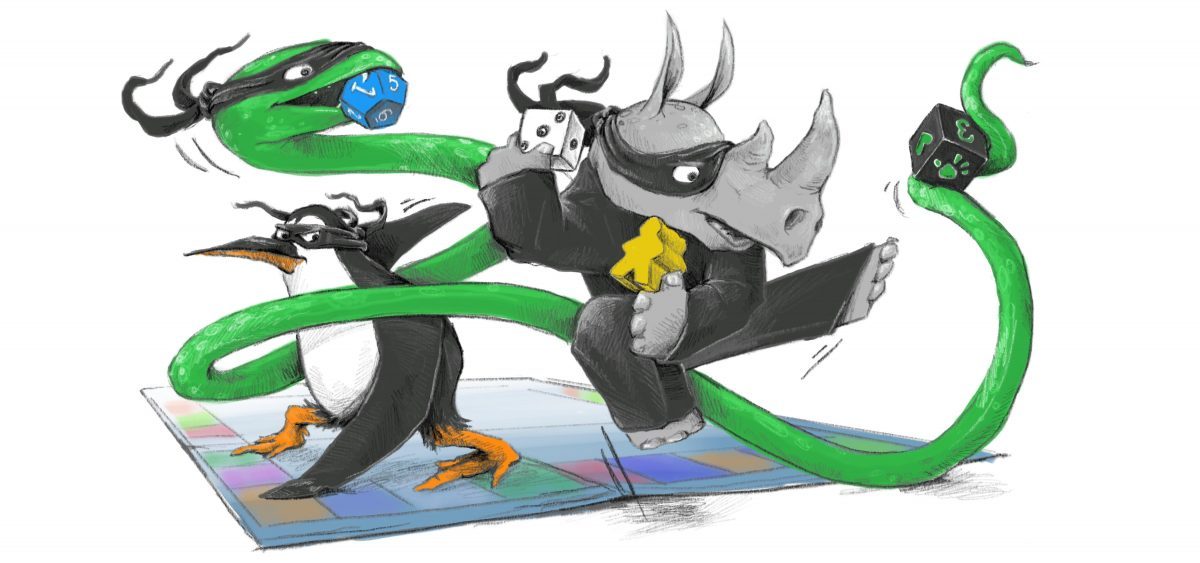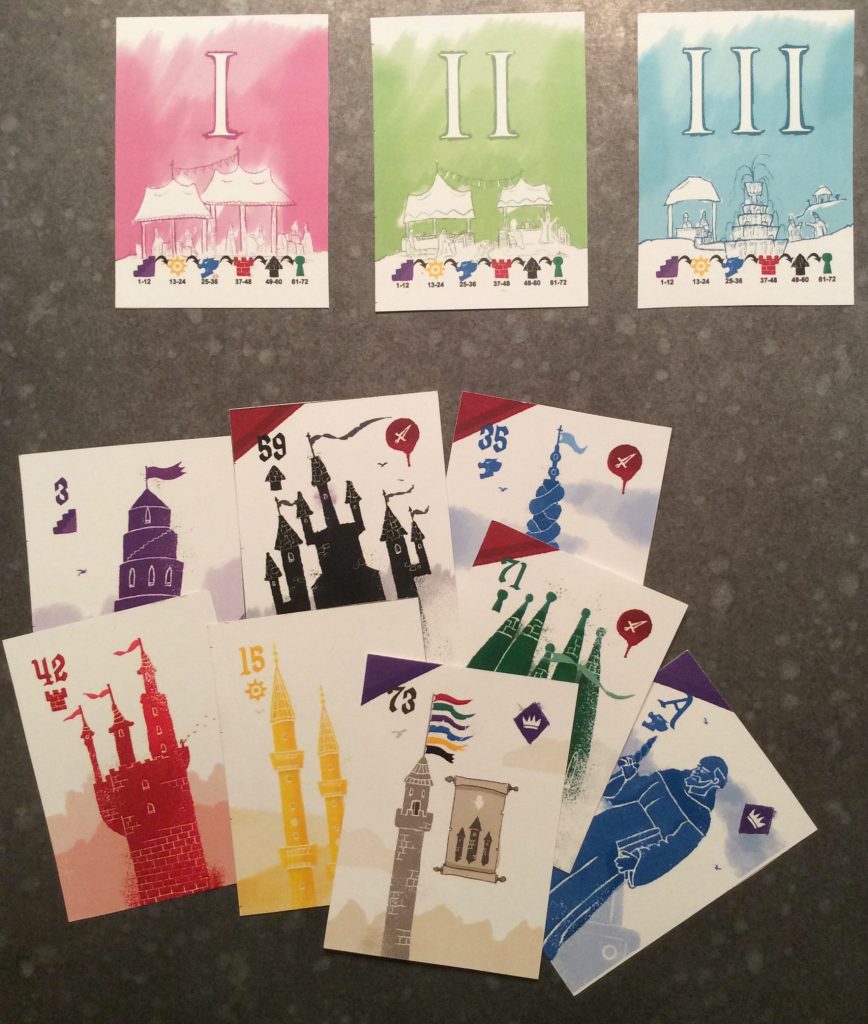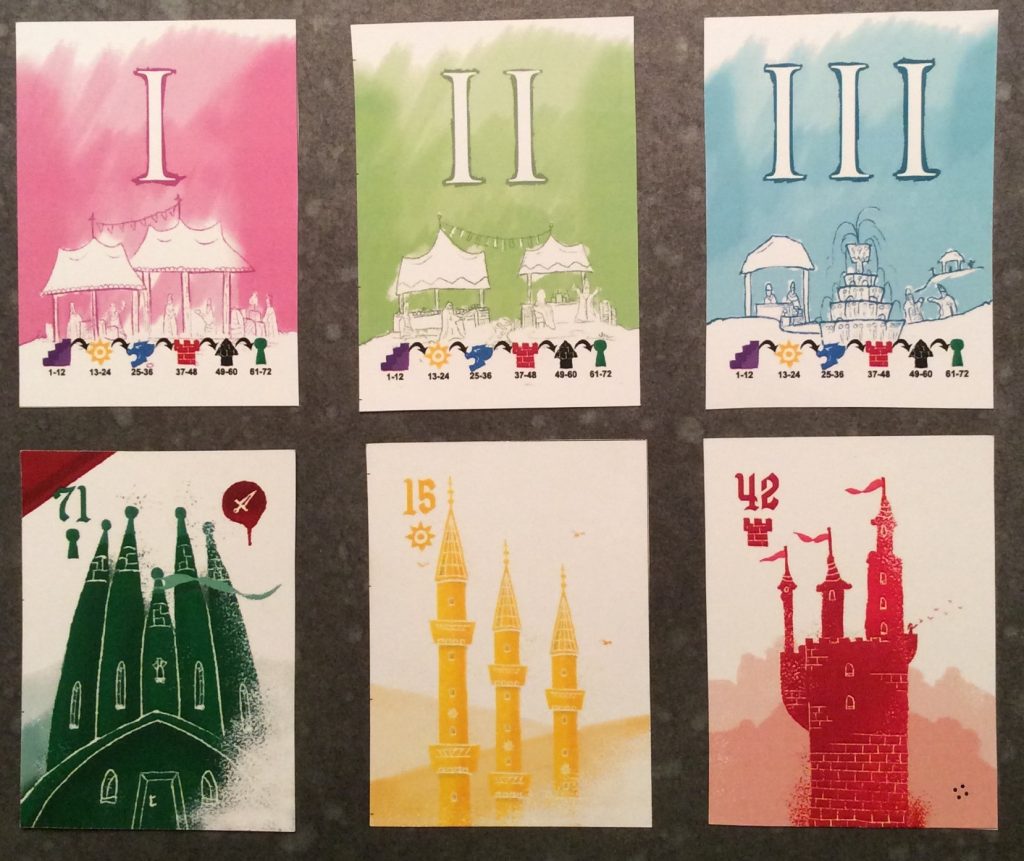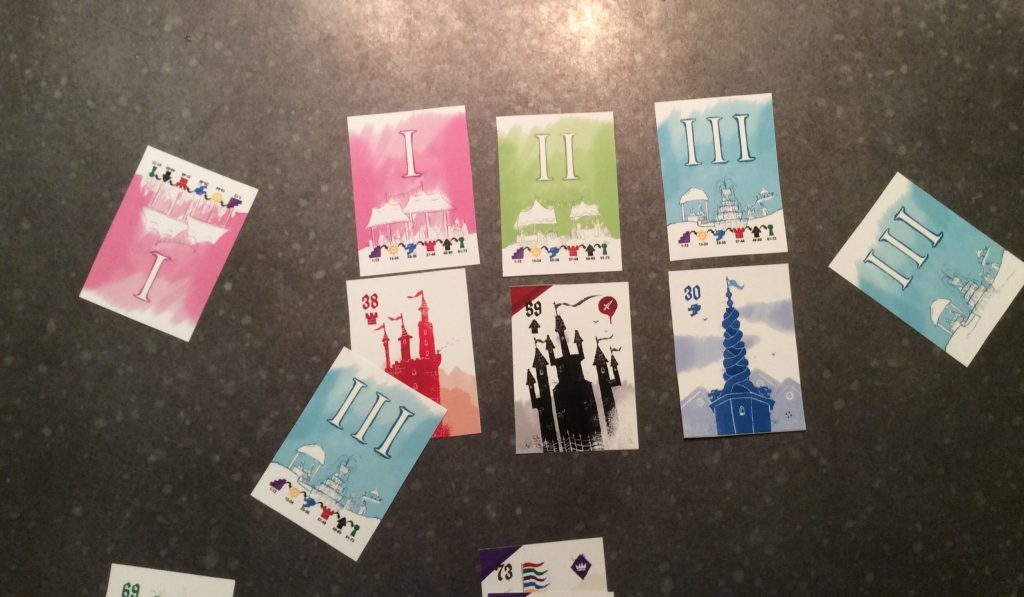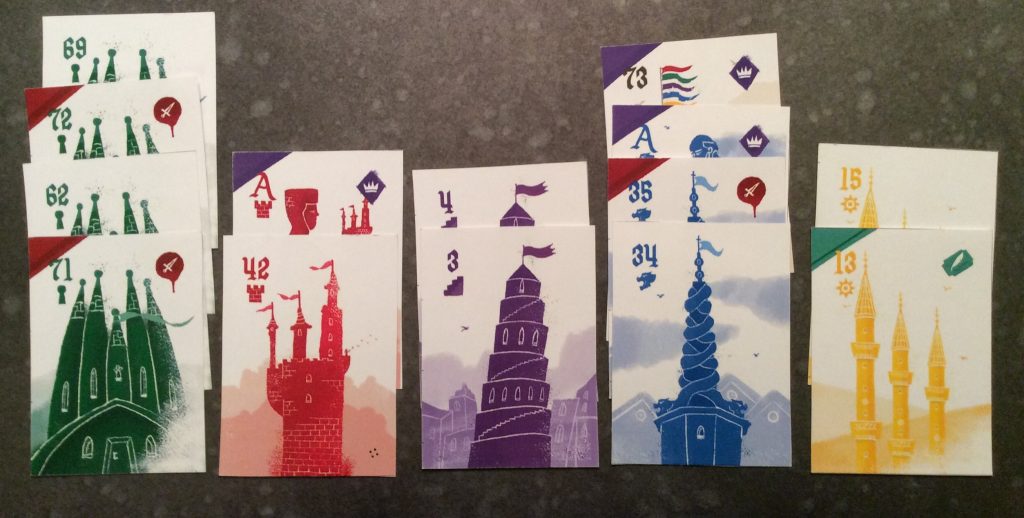It is a fantastic thing when you find a game with exceptional artwork and then discover that the gameplay equals the beauty. Such is the case with Spires, a new game by T.C. Petty III with art by Bryan Fischer.
When I first saw the cards for this game, it was just in passing and I stopped immediately to try and figure out what the game was. What it is, is gorgeous.
But beyond that, it is an extremely well-balanced game with a ton of strategic possibilities and loads of replayability.
Let’s take a look at the game:
Spires is a card game consisting of 6 different suits and a handful of specialty cards. It is a game of set-collection with bidding elements and a certain “take that” factor lurking underneath. A lot of complexity in a concise game.
Your goal is to construct Spires of the different suits. You mustn’t, however, build them too high. If you have Spires more than 3 cards high in your tableau at the end of the game, they count against you (-1 for each card present in that Spire). Any of 3 or less score you 5 points for every card in the Spire. There are also Scroll cards, some of which provide special actions, others just add bonus points to your score.
Gameplay consists of 4 phases: Plan, Compete, Refill, and Draw up.
At the beginning of the game, players will set up an area in the center of the table consisting of 3 Markets. Each player receives 5 cards and then play begins.
Plan phase: All players examine all of the available Markets and decide which card they would like to add to their tableau, and secretly choose the Market card that corresponds to that Market to reveal. Once everyone has decided, everyone reveals their cards at once.
If there is only one player attempting to claim a card in a Market, they collect the card immediately and place it in their tableau on the Spire of the same suit. If there are two or more players who are attempting to claim a card in the same Market, the players must compete.
Here, the player who chose Market 1 will claim the card without competing. The other two players will compete for the card in Market 3.
Compete phase: Each player must now choose a card from their hand to “bid” on the Spire. The highest card value played wins the card in the Market. The suit of the card in the Market acts as a trump suit, making any card of that suit a higher value than any off-suit card. The player who wins the competition takes the card in the Market as well as all cards played in the bidding competition and adds them all to their tableau in the appropriate spire column. This is repeated for every Market that is in contention.
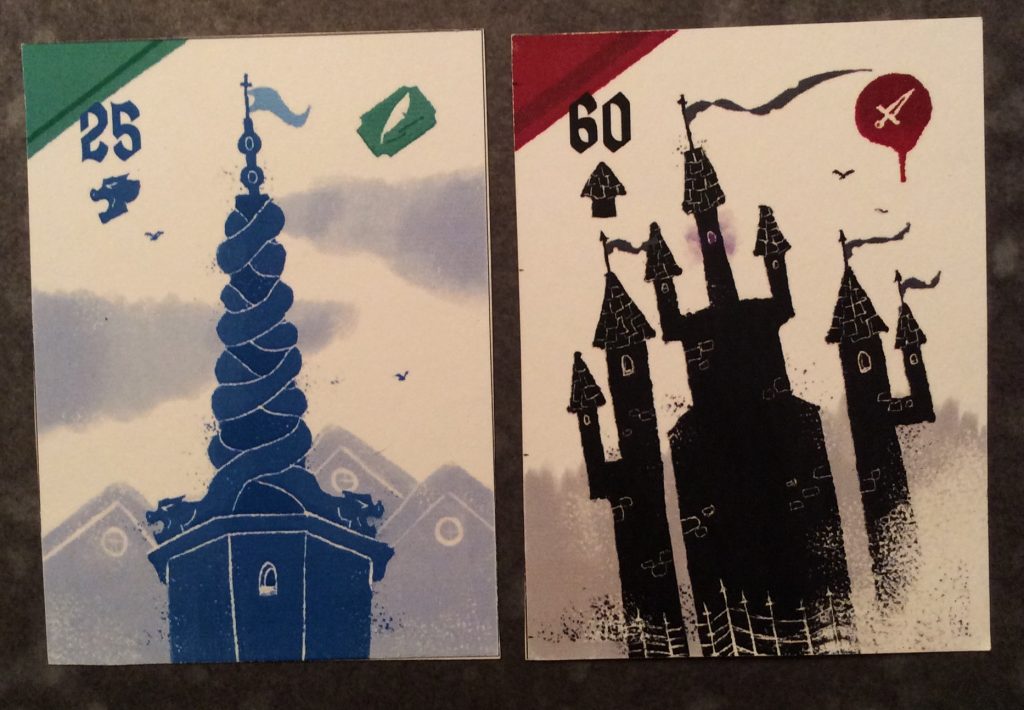 In this example, the Blue card matches the suit of the card in Market 3, so it is the winning card even though it is of higher numerical value than the Black card. The player who played the Blue card takes both of these cards and the one in Market 3 and adds them to their tableau.
In this example, the Blue card matches the suit of the card in Market 3, so it is the winning card even though it is of higher numerical value than the Black card. The player who played the Blue card takes both of these cards and the one in Market 3 and adds them to their tableau.
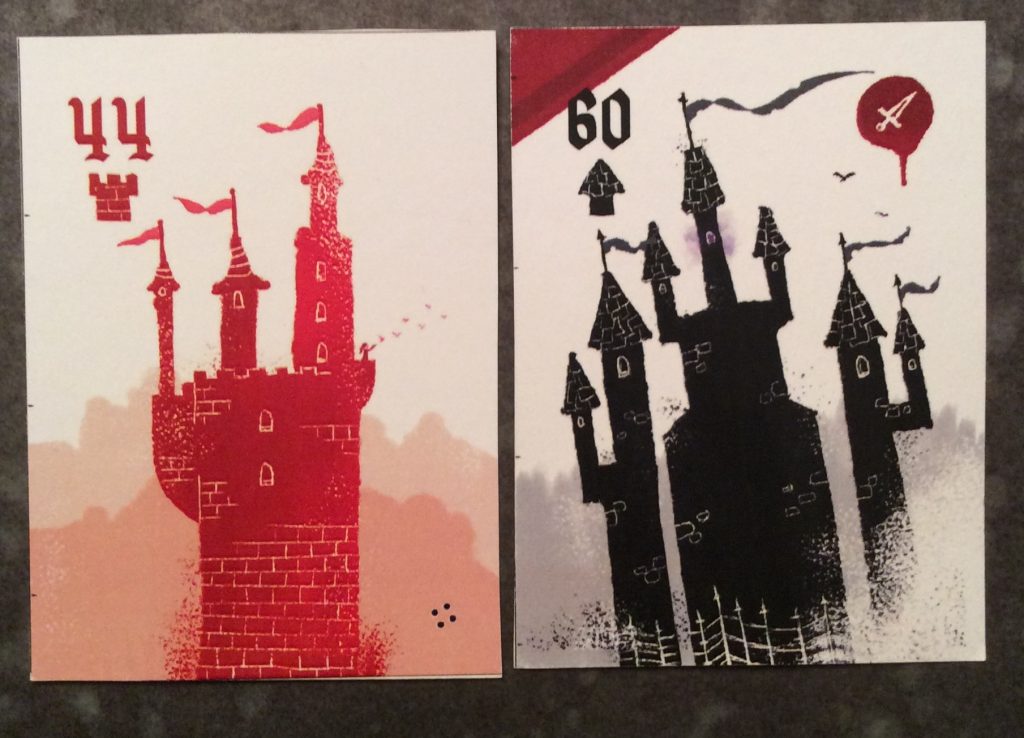 In the second example, there is no card matching the suit of the card in Market 3, so we simply compare numerical values. The Black card wins this competition and the player who played it collects these two cards plus the one in Market 3 and adds them to their tableau.
In the second example, there is no card matching the suit of the card in Market 3, so we simply compare numerical values. The Black card wins this competition and the player who played it collects these two cards plus the one in Market 3 and adds them to their tableau.
If both cards had been Blue, the highest numerical value wins.
Refill phase: Every Market that was emptied is refilled by drawing the top card from the deck.
Draw phase: All players who competed for a Market card draw up to 5 cards. Any players who acquired a Market card without competing for it do not draw up and will play the next round with 1 fewer card.
Once the draw deck is depleted, you play until all Market cards are collected. The game now ends and each player selects 3 cards from their hands to add to their tableau. Everyone adds up their totals (subtracting negative points) and the highest score wins.
There are also Scroll cards, Architect cards, and two special cards (the 73 and 74). The Scrolls are worth bonus points or allow you to discard cards from your tableau. The Architect cards are like Aces. They are considered the highest card of a suit during a competition if they match the suit of the Market card, but the lowest if they do not. The 73 and 74 must be added to the tallest Spire in your tableau when claimed.
So…is it worth picking up?
Oh yes! Go immediately and back this game on Kickstarter.
First, as I said before, the artwork is incredible. The cards are gorgeous and I would almost pick this one up simply based on the art. Luckily the gameplay backs up the art. The copy we reviewed is a PNP copy but the card artwork doesn’t figure to change, as it is fantastic. (Did I mention the artwork?)
The gameplay is very clever. Your goal is to strike a balance between taking the cards you want and not taking too many of the cards that you already have in your tableau. There will be times when you do not want to win any of the cards in the Marketplace because they will cause you to have Spires of more than 3 cards, and therefore have negative points at the end of the game. So you may want to compete for a card and bid off-suit and/or very low so that you don’t win any of the available cards.
There may also be the added benefit of being able to screw over your opponent as well. You see, everyone’s tableau is visible at all times, so you can always tell how many cards your opponent has in each Spire. So if you are unable or unwilling to win a card from the Marketplace, you may be able to force your opponent to take a card that they would not want to add to their tableau. In this way, you can turn one of their Spires worth 15 points into one worth -4 points very quickly. This “take that” factor is a fabulous aspect of the game that adds a lot of plotting and scheming, and frankly, a lot of fun.
There is also another balancing element built into the game. Some of the cards have symbols on them in addition to their suit symbols. These are Crowns, Swords, and Quills. At the end of the game, whichever player has the most of these symbols in their tableau scores bonus points. This can be a nice consolation prize if you have several Spires in your tableau with more than 3 cards: “At least I had the most Crowns!”
The final play of the game is also an interesting mechanism for balance. Because you have to add 3 of your final cards to your tableau, sometimes you may want to purposely lose the last Market card in order to keep your spires the right height, and also force an opponent to take one of your cards that will force one of their spires to be too tall.
Spires plays well with each different number of players, including the solo game. It strikes a good balance between deep strategy and casual fun, which allows you to make the game as complex and devious as you want, while still being easy to teach. When I first started teaching it to myself, I felt like it was going to be a very straightforward simple card game, but I soon began seeing all the ways I could screw over my friends. Which of course makes it even more fun.
I keep thinking about this one, trying to figure out which group I can get to try it next. I can’t wait to get a real copy of the game so I don’t wear out the PNP.
I really, really like this game.
Ninja approved!
Spires is on Kickstarter Now:
https://www.kickstarter.com/projects/nevermoregames/spires-a-card-game-for-1-4-players
The copy we reviewed was a Print and Play copy, but we played it a bunch anyway.
